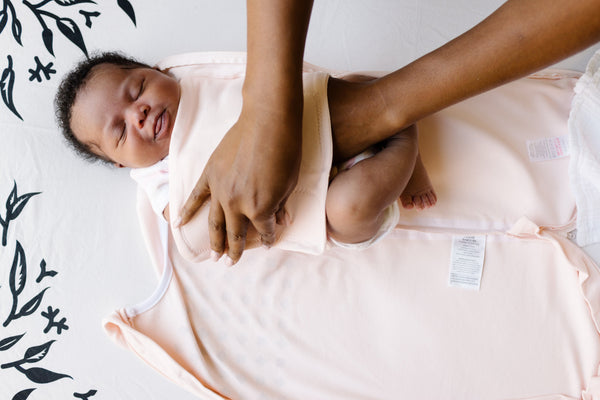Reviewed by Nanit Lab's Dr. Natalie Barnett.
How long can you swaddle a baby per day?
As a new parent, you may have a lot of questions when it comes to swaddling, and understanding the benefits of swaddling can put your mind at ease. Swaddles may seem restrictive or uncomfortable for the parent, but for most babies, the feeling of being snugly wrapped feels like a warm hug. It simulates the environment of the womb and helps prevent newborns from being disturbed by their own startle reflexes.
You might already know what swaddling is and how to swaddle a newborn, but just how long can you swaddle a baby? Is it bad to spend too much time in the swaddle?
If you’re wondering how long to swaddle a baby per day, the answer depends on your baby’s age and development. Newborns spend as much as 17 hours per day asleep, and can safely spend most or all of that time swaddled. Keep reading to find out how many hours per day is best for your baby, as well as safety tips and signs to stop swaddling.
How many hours per day should a baby be wrapped?
How long can I swaddle my baby? It’s a question most new parents will find themselves asking sooner or later. During the first few weeks of life, babies sleep for most of the day and night—with fairly consistent awakenings for feedings, of course. And we’ve got good news: At this stage, it’s safe to swaddle babies for most of their sleeping hours.
Most experts suggest 12 to 20 hours of swaddling per day is safe for the first few weeks, depending on how your little one takes to it.
Dos and don’ts of swaddling
When you get started on swaddling your newborn, follow these dos and don’ts to make sure you’re wrapping them safely and comfortably:
- Do be consistent. Swaddle for both daytime naps as well as nighttime sleep, so that your baby associates the swaddle with sleeping.
- Do leave room around the lower body. The swaddle should always be wrapped loosely enough to allow free leg and hip movement. A swaddle that keeps baby’s legs straight is a major risk factor for developing hip dysplasia. Keep the swaddle loose enough to allow baby’s legs to relax into the normal frog-legged pose.
- Do lay your baby flat on their back. Babies should never be placed on their stomach or side to sleep, swaddled or not. Stomach sleeping is associated with a higher risk of sudden infant death syndrome (SIDS). Once your baby starts showing signs of or starts rolling over, it’s time to stop swaddling–consider using an arms-out swaddle or sleep sack to support the transition.
- Don’t constrict breathing. The swaddle should be snug around the upper body, but not tight. Leave enough space so that you can slide two or three fingers between baby’s chest and the blanket.
- Don’t use any loose bedding in addition to the swaddle. A baby’s sleeping area shouldn’t contain anything but a crib mattress and a fitted crib sheet.
- Don’t force it. Not all babies take to being swaddled, and swaddling isn’t necessary for safety or health. If your baby sleeps well without a swaddle or has started to kick or squirm when you try to wrap them, it’s fine to let them sleep unwrapped.
As your baby gets older and starts sleeping for longer stretches at night and being more active during the day, start gradually reducing the amount of time they spend in the swaddle. By 3 to 4 months of age, most babies are starting to roll over on their own. At this point, it’s no longer safe to swaddle.
Is it ok to swaddle a baby all night?
Swaddling is safe for nighttime sleeping as long as the swaddle is wrapped correctly. It’s essential to follow safe swaddling guidelines to reduce the risk of overheating or suffocation.
While you don’t want your baby to get too chilly, it’s also important to avoid a heavy swaddling blanket that can hold in too much heat, since overheating is also a risk factor for sudden infant death syndrome (SIDS). In general, babies only need a little more insulation than adults do to keep warm. A good rule of thumb is to apply one more layer than you would need to feel comfortable.
If you choose to swaddle your baby all night, here are a few safety tips to keep in mind:
- Keep the room between 68 to 72 degrees Fahrenheit
- Choose a swaddle that’s appropriate for the temperature of the room, not too thick and not too thin
- Don’t cover baby’s head with a hat or the swaddling blanket, as this can cause overheating
- Feel baby’s chest and the nape of the neck—if they feel sweaty and damp, switch to a lighter swaddle or remove a layer of sleeping wear
- If you have trouble wrapping your swaddle securely, try a swaddle with built-in velcro or zippers that make the perfect swaddle easy to achieve every time
- Use one layer of clothing under the swaddle, such as a onesie or pajamas over diapers
Am I swaddling my baby too much?
How long do you swaddle babies who never seem to be tired of being wrapped? While your baby may find the swaddle so soothing that they’d stay in it all day, it’s vital to balance it with plenty of unswaddled time. Babies need time every day to stretch and move freely in order to develop their muscles and mobility.
To help your little one get that all-important exercise and stimulation, be sure to provide several sessions of supervised tummy time every day. Tummy time is key for:
- Developing muscles in the upper body, neck, and arms
- Preventing flat spots on baby’s head
- Building motor skills and perception
You can start doing tummy time with your baby once the umbilical cord has fallen off. Begin with a few minutes several times a day. As baby grows and begins to enjoy the activity, you can increase the duration and frequency. If your baby doesn't like tummy time and gets upset quickly, pick them up and practice again in a few hours. It might take some consistent practice for them to enjoy tummy time, but keep at it!
According to the National Institute of Child Health and Human Development, babies need:
- 15 minutes of tummy time in 2-3 sessions per day from birth
- 15-30 minutes a day of tummy time by 2 months of age
- 60- 90 minutes of tummy time throughout the day by 6 months of age
What are signs to stop swaddling?
Every baby has to leave the swaddling stage behind as they reach their next stage of development.
How will you know what age to stop swaddling or when this time has come? Here are four signs that the swaddle needs to be retired:
- Baby is learning to roll over. Once your baby can roll over, swaddling is a safety risk. Start transitioning them out of the swaddle as soon as you see signs that they’re trying to roll, such as scooting in a circle, lifting the hips, or rolling onto one of their shoulders.
- Baby’s startle reflex has faded. Have you ever seen your sleeping baby suddenly fling her arms wide and startle herself awake? This is what’s known as the Moro reflex, and it often causes babies to jerk awake and start crying. Swaddling prevents this reflex from disturbing the baby's sleep. As your baby grows the Moro reflex fades (usually around 3 to 4 months), and makes swaddling unnecessary.
- Baby is fighting, loosening the swaddle, or breaking out. If your baby can kick or wiggle out of their swaddle, it’s no longer safe to use a swaddling blanket because the loose fabric is a safety hazard in the sleeping space. Instead, opt for a Nanit Swaddle which has a comfy inner Velcro to help secure the wiggles.
- Baby is showing signs of discomfort while being swaddled. Even if baby loved being swaddled once upon a time, being wrapped up tight may become more frustrating than soothing as they get bigger and wigglier and want (and need) to be moving and growing.
For comfort and safety, add Nanit to your baby’s bedtime
No matter how much or little you choose to use swaddling with your baby, be sure you follow safe sleep guidelines and wrap your swaddle with care. Follow baby’s lead to decide when they’re ready for more freedom of movement during sleepy time. Remember, once they’re ready to roll, the swaddle needs to go.
At every stage of your baby’s growth and development, Nanit Sleep Wear and Breathing Wear are the perfect fit. Enjoy more peace of mind when you make Nanit part of your baby’s bedtime routine.
Editorial Team
Dr. Natalie Barnett:
 Natalie Barnett serves as VP of Clinical Research at Nanit. Natalie initiated sleep research collaborations at Nanit and in her current role, Natalie oversees collaborations with researchers at hospitals and universities around the world who use the Nanit camera to better understand pediatric sleep and leads the internal sleep and development research programs at Nanit. Natalie holds a Ph.D. in Genetics from the University of New England in Australia and a Postgraduate Certificate in Pediatric Sleep Science from the University of Western Australia. Natalie was an Assistant Professor in the Neurogenetics Unit at NYU School of Medicine prior to joining Nanit. Natalie is also the voice of Nanit's science-backed, personalized sleep tips delivered to users throughout their baby's first few years.
Natalie Barnett serves as VP of Clinical Research at Nanit. Natalie initiated sleep research collaborations at Nanit and in her current role, Natalie oversees collaborations with researchers at hospitals and universities around the world who use the Nanit camera to better understand pediatric sleep and leads the internal sleep and development research programs at Nanit. Natalie holds a Ph.D. in Genetics from the University of New England in Australia and a Postgraduate Certificate in Pediatric Sleep Science from the University of Western Australia. Natalie was an Assistant Professor in the Neurogenetics Unit at NYU School of Medicine prior to joining Nanit. Natalie is also the voice of Nanit's science-backed, personalized sleep tips delivered to users throughout their baby's first few years.Sources
American Academy of Pediatrics. How to keep your sleeping baby safe: AAP policy explained. https://www.healthychildren.org/English/ages-stages/baby/sleep/Pages/a-parents-guide-to-safe-sleep.aspx
The American Journal of Maternal Child Nursing. Risks and benefits of swaddling healthy infants: An integrative review. https://pubmed.ncbi.nlm.nih.gov/28394766/
National Institute of Child Health and Human Development. Benefits of tummy time. https://safetosleep.nichd.nih.gov/reduce-risk/tummy-time
St. Louis Children’s Hospital. The right way to wrap. https://www.stlouischildrens.org/health-resources/pulse/right-way-wrap
Stanford Medicine Children’s Health. Newborn sleep patterns. https://www.stanfordchildrens.org/en/topic/default?id=newborn-sleep-patterns-90-P02632







































